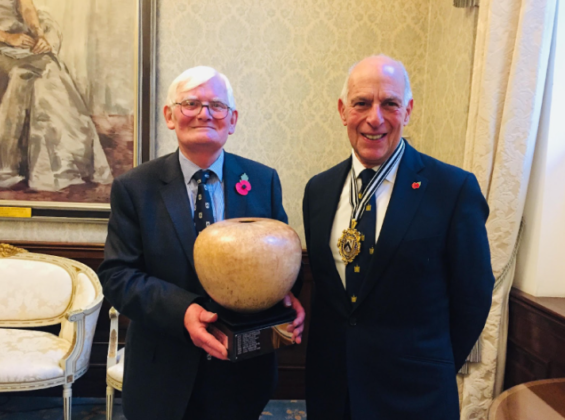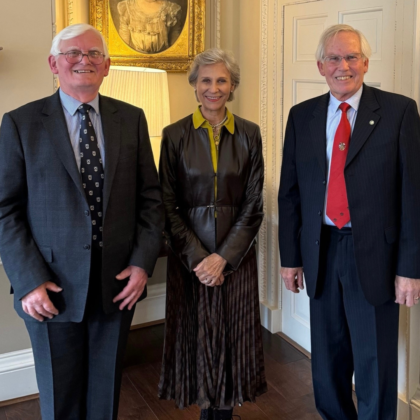In 2003, at a pivotal time for the Institute of Carpenters, John Taylor MBE joined the IOC board through the Worshipful Company of Carpenters. With his steady guidance and deep-rooted passion for craft, he has played an essential role in shaping the Institute’s path forward, working closely with leaders like William Avery and Geoff Rhodes to secure a bright future for the IOC.
John’s journey into carpentry began early, growing up in a family craft business where he quickly learned his way around a hammer and chisel. His hands-on expertise, complemented by his engineering background at Cambridge and a long-standing career with the Royal Engineers, became the foundation of his commitment to the heritage and craftsmanship sectors. Over the years, he has held esteemed roles, including Chief Executive of the British Urban Regeneration Association and Director of the Building Crafts College. Even in retirement, his involvement remains strong, with contributions to numerous heritage initiatives and skills councils.
John’s dedication extends beyond these accolades. As an ambassador for the IOC, John has built vital connections with outside organisations, championing the next generation of craftspeople. In his own words, “The IOC offers unparalleled access to world-class expertise in all matters of wood.”
In this interview, we have the privilege of hearing directly from John about his experiences, reflections, and hopes for the future of carpentry and craftsmanship, ahead of his retirement as Vice President of the IOC.

You have been with the IOC since 2003, a pivotal time for the organisation. What were some key challenges and achievements during this transition, and how did you envision the future of the IOC back then?
When I joined, the IOC was facing serious financial issues. Under President William Avery, we had to make tough decisions, including staff reductions. This helped stabilise the organisation and allowed us to rebuild, with a focus on the next generation. Today, I am proud to say we have re-established the IOC as a credible organisation, especially in supporting young talent in the industry.
Growing up in a family craft business, what early lessons shaped your approach to craftsmanship and leadership?
I was always hands on from a young age. Craft skills were highly valued back then, and I’ve always enjoyed making things. These early experiences instilled a love for practical work and a respect for skilled craftsmanship, which has been central throughout my career.
How did your military experience prepare you for your roles in the heritage and craft sectors?
Readers may not know that the Royal Engineers are both combat-ready and skilled artisans – we held dual trades, you might say. It meant that we were very versatile – building bridges, handling explosives and clearing mines but also had all the combinations of construction skills, for example, to build a school in The Gambia. This duality taught me the importance of versatility and practical problem-solving – skills that are invaluable in construction and heritage work.
What sparked your interest in traditional building skills, and can you share a memorable project that deepened your connection to heritage craftsmanship?
Growing up in an old cottage and later living near Bath and being surrounded by historical architecture sparked my interest. My work with English Heritage and the Building Crafts College allowed me to understand and promote the value of heritage skills, which has been incredibly rewarding.
How has the heritage sector evolved since you first became involved, and what challenges remain?
There is now a stronger emphasis on preserving historical buildings and integrating old and new structures thoughtfully. During the late 1950’s and 1960’s, organisations campaigned to identify key buildings to be saved. For example, the original plan for King’s Cross was to clear it and start again. This didn’t happen due to the recession at the time, but when funds became available, there was a more enlightened approach and thought was taken to preserve and sensitively adapt the important historic buildings such as St. Pancras Station and old industrial warehouses.
With regeneration now there’s a general view that you need to make sure that you are looking carefully at the value of the buildings. However, we still need to raise awareness about the importance of conservation skills within the industry to ensure these buildings are maintained properly.
As IOC Vice President, you have acted as an ambassador. What legacy do you hope to leave, and where do you see the IOC heading in the future?
I hope the IOC continues to inspire young people and showcase the broad scope of our craft. I want to see us continue placing woodworking skills within the broader context of the timber industry. There is much more to carpentry than volume house-building!
What advice would you offer young carpenters and craftsmen in preserving traditional building skills?
Strive for excellence and do not settle for the minimum. Embrace opportunities like the Carpenters’ Craft Competition to push your skills. Working on historical buildings connects you to the past—it is both challenging and rewarding.
Is there a project or collaboration during your time with the IOC that stands out as particularly meaningful?
The Master Certificate Scheme, which recognised the experience of seasoned carpenters without formal qualifications, was very impactful. It was a true collaboration and ran successfully from 2007 to 2010. I hope we can bring something similar back.
As you step down from your position, do you plan to stay involved in the heritage and craftsmanship sector? What’s next for you?
Craft and heritage are in my blood, but at 80 years old, I need to step back a bit. As far as the IOC is concerned, I will remain involved in the Carpenters’ Craft Competition and will certainly do what I can to support the sector.
The NAS and IOC wish John the very best in his retirement from the IOC Board and thank him for his invaluable contributions to the industry.



